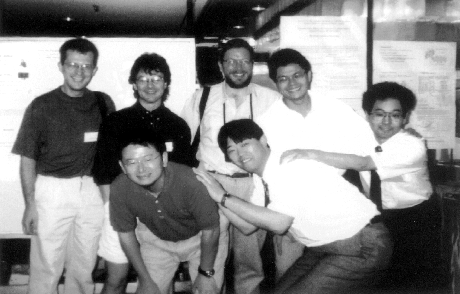
Visitor:
Shigeki Nagaya
(TRC Information Integration Laboratory)
Period: June 24 - July 1, 1996 (8 days)
Places (attended conference):
1) 1st Asia-Pacific Conference on Human Computer Interaction(APCHI
'96)
2) ISS (RWCP Overseas Distributed Laboratory)
This is a report on my technical trip to Singapore to participate in and give
a presentation at the 1st Asia-Pacific Conference on Human Computer Interaction
(APCHI '96). The trip was also to learn about the research trends on human
interface and multimodal interface and to have discussions with ISS researchers,
one of the RWCP Overseas Distributed Laboratories.
APCHI '96
The Asia-Pacific Conference on Human Computer Interaction (APCHI) was held
for the first time as a regional meeting of the Conference on Human Computer
Interaction (CHI)*1 for researchers in the Asia-Pacific region. Since the HCI
Group of IT 2000*2 served as the host of the conference, it was held in
Singapore*3. About 50 presentations were given at the conference. It was a
rather small meeting as international meeting go but the discussions were
high-level with quality papers.
The main theme of the conference was 'Human Factors'. Presentation subjects
included the design, evaluation methods and application examples of human
interface and CSCW (computer-supported cooperative work)*4 sessions were held as
well.
The geographical breakdown of speakers was 19 presentations from Oceania, 12
from the UK, 10 from Singapore, Malaysia and Thailand, 6 from Japan (3 from
RWCP) and 3 from China, thus a small slot for Japan. Stringent review of papers
are common among international organizations related to human interfaces.
In addition to myself, Dr. Endo and Dr. Mukai from the Information
Integration Laboratory, RWCP, participated in the conference and gave a
presentation and demonstration on the Information Integration Station
(Multimodal) and multiple user support technology for multimodal interfaces.
They were well-received; not only by people from universities, but also senior
researchers from private institutes such as Apple Computer, Microsoft and
AT&T gave many questions and comments on our presentations.
Most impressively, our multimodal interface technology solicited a
sensational response and was positively evaluated as a unique human interface
technology. The current status of our technology is still at the experimental
level so we have to improve the individual element technologies and develop new
functions. It should be evaluated not only from the perspective as a recognition
system, but also as a human interface, and this cycle of evaluation and redesign
must be repeated to further refine it as the human interface architecture for
the next generation.
Another result of participating in APCHI '96 is that I learned of some
projects of other countries, including the IT 2000 of Singapore and CSIRO
(Commonwealth Scientific Industrial Research Organization) of Australia*5.
ISS, RWCP Distributed Laboratory
During the second part of the trip, we visited the ISS Distributed Laboratory
and met Professor Jian Kang. They gave us a guided tour of their facilities and
the opportunity to discuss in detail with Professor Kang the research
cooperation programs for the second half of the Real World Computing project.
Our discussion focused on an on-going joint scheme between the Information
Integration Laboratory of TRC and the ISS Distributed Laboratory to compile
research data on the Information Integration Station.
I also had the chance to exchange opinions in detail with ISS researchers on
the following three specific areas for aggregating novel functions on the
Information Integration Station: (1) the specific aggregation method, (2) a
method for implementing interface between novel functions, and (3) the outline
of aggregation schedule. The face-to-face discussion was a great opportunity for
me to reach agreement on several critical issues as well as to promote mutual
understanding.
The Singaporean economy is now in a boom period and investments are
aggressively being made in facilities and equipment and in research and
development. The IT 2000 project is a reflection of this active investment.
Unlike Japan, however, emphasis is placed on the research and development of
products that have more competitiveness and/or more immediate usability. This
perhaps reflects the Singaporean nature for more immediate results than the
Japanese*6.
*1 CHI is the world's largest international conference on human interfaces.
It is held annually by ACM.
*2 IT 2000 is a joint project in which the Singaporean industries and the
Information Technology Institute (ITI) play key roles. The focus is the
development of products with international competitiveness and product
usability. ITI is an academic institute without any students. Nearly half of
their 180 researchers are engaged in research on human computer interaction.
*3 APCHI will be held in Sydney, Australia in 1997 and in Japan in 1998.
*4 CSCW (Computer-Supported Cooperative Work) is a general term for computer
systems used to support cooperative work between people. "Personal" support was
suggested for the first time in the mid 1980s.
*5 CSIRO (Commonwealth Scientific Industrial Research Organization) is a
project jointly conducted by universities and the agricultural, mining and
manufacturing industries of Australia. Its final goal is to develop technologies
that will make effective use of the rich natural resources of the country.
*6 In Singapore, the speed of escalators in subway stations is clearly two
times faster than those in Tokyo. Also, the duration of the green traffic light
for the walkers is almost one half that in Tokyo. Is Singapore safe for senior
citizens?

Professor Thimbleby, the keynote speaker at APCHI'96 (back row,second from
the right), and Nagaya, Mukai and Enfo of RWCP(from left to right in the front
row)

